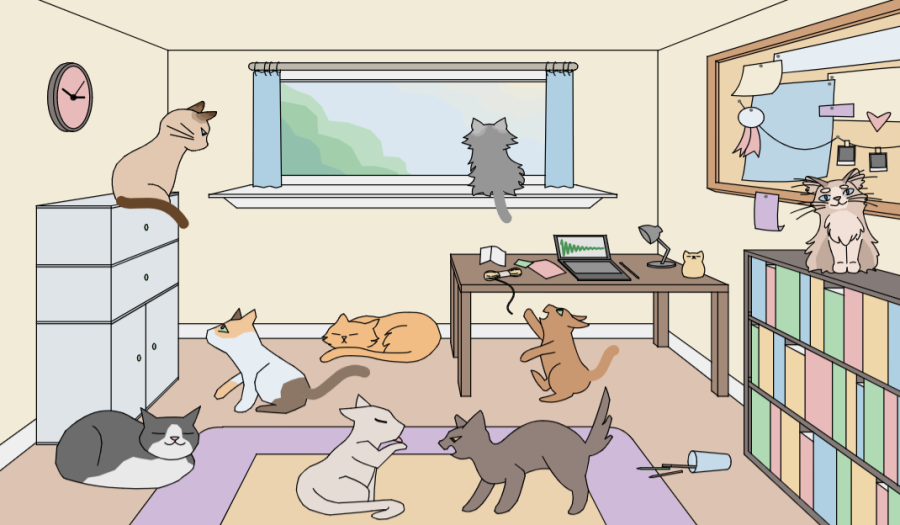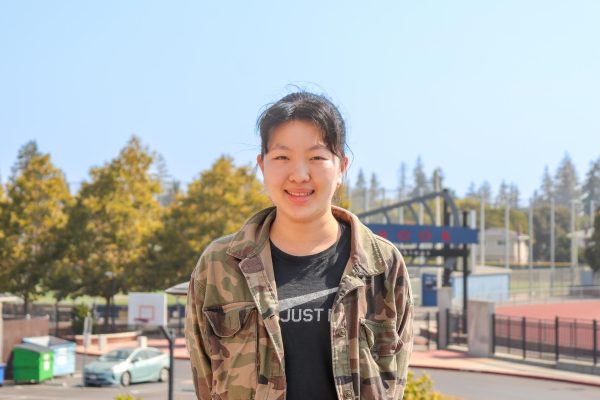Precalculus classes discover art using Desmos
Photo used with permission of Valerie Shu
Shu’s Desmos art piece, “Nine Lives in Perspective,” features nine cats each created with a different equation.
May 3, 2022
The ticking clock on freshman Valerie Shu’s graphic illustration looks deceivingly simple. However, she spent hours experimenting to make the second hand move and pause each second in Desmos. Polynomial equations with sliders create the cats’ wagging tails, bringing life to the comfy room in Shu’s art.
On March 28, Precalculus Honors and Precalculus students graphed polar curves for a project through Desmos. It was the first time this project was assigned, and students explored this creative aspect of graphing while also reviewing various functions learned throughout the course of the year.
Students created a title and an artist statement, a description of what the student intends for viewers to explore and understand through their art. Students also implemented color by customizing the shade of inequalities and worked with animations by using the moving sliders feature.
“They not only learned in terms of the math but also discovered the various tools available on Desmos that they would normally not bother to use,” Precalculus Honors teacher Vivian Frazita said. “Being able to use the sliders to animate something is pretty cool.”
Art pieces ranged from the solar system to vases of flowers. Some students combined many elements in their art piece to experiment with more types of functions.
“My art piece depicts a pig strolling around at night,” sophomore Apurva Krishnamurthy said. “I also have windmills that spin nearby and flashing stars across the sky.”
One common challenge among students was finding the right positioning of elements in their art pieces, which they solved by guessing and checking continuously. Students found the process rewarding, proud to have created an art piece through graphing.
“The most interesting aspect of the project was how you could integrate a message into your work and create a whole story based off of the image,” Krishnamurthy said. “The project was really fun because I was able to explore a side of math that I had never known about.”
Students also discovered various new tools in Desmos that they had not known about before.
“From this project, I learned a lot of things about using Desmos, such as creating folders to organize equations and making different colors for our graphs,” sophomore Hannah Ding said.
However, the tools available on Desmos were not novel to all students. In both 2020 and 2021, Shu participated in the Desmos Global Math Art Contest, winning first place in the age group for 15 and 16 year olds in 2021. She first learned about the competition while doing homework on Desmos, and she was eager to try something new and out of her comfort zone.
She named her art piece “Nine Lives in Perspective,” which was inspired by the belief that cats have nine lives. However, the most astounding part of her work was that each cat was distinct in mathematical nature: Linear, parabolic, cubic, exponential, logarithmic, sine, arcsine, elliptic and Bezier curves distinguished each of the nine cats’ composition, coat and color. The piece was brought to life with the ticking clock and the cats’ wagging tails.
“In my second time participating, I wanted to incorporate a bunch of different types of equations, which brought up the idea of cats,” Shu said. “The clock animation was a detail that was especially difficult to make.”
Her experience in the contest gave her valuable experience working with various equations and matching graphs to what she has in mind.
“Making art on Desmos definitely helped me become more familiar with transformations and visualize different types of equations,” Shu said. “Now, in my Algebra 2/Trigonometry class, I don’t struggle as much with graphing.”



































































